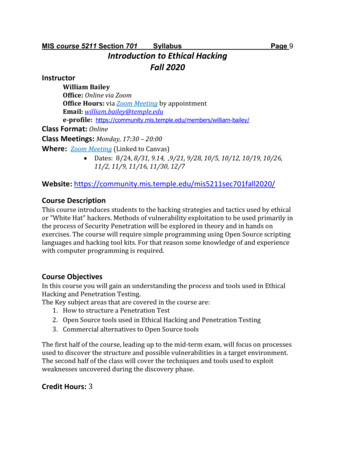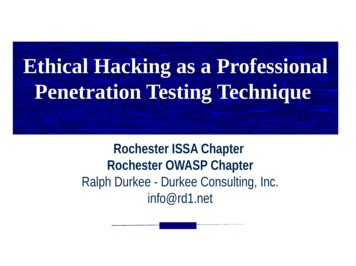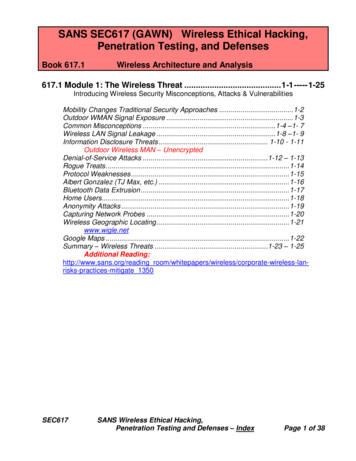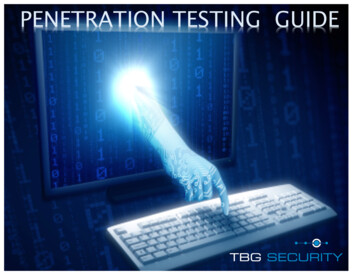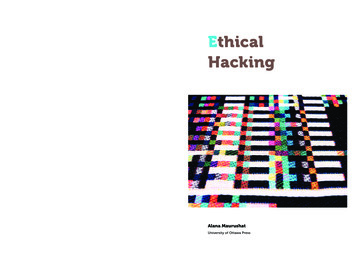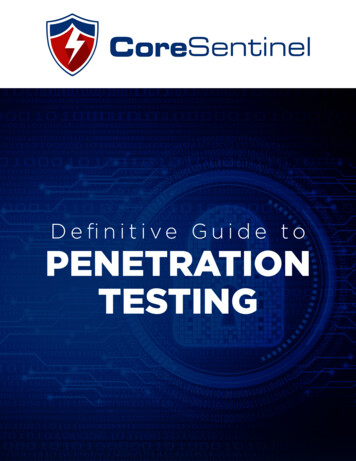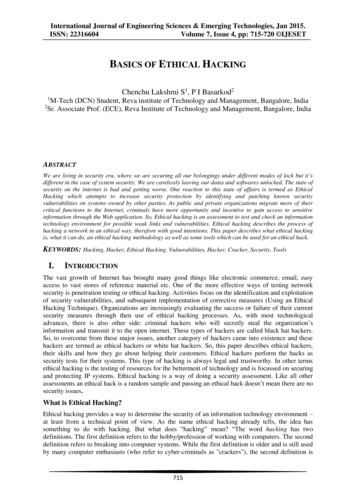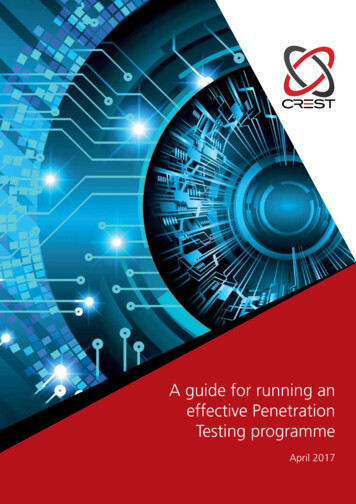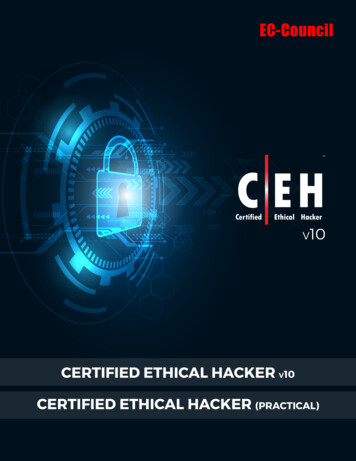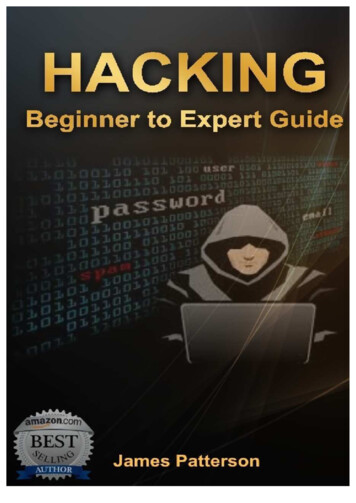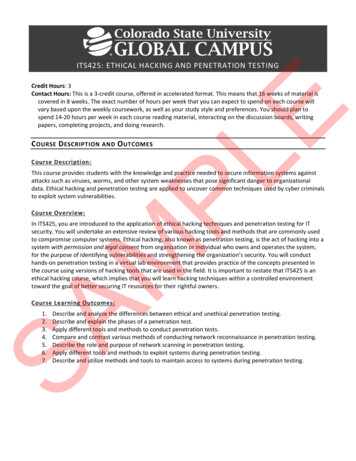
Transcription
ITS425: ETHICAL HACKING AND PENETRATION TESTINGCourse Description:PLC OURSE D ESCRIPTION AND O UTCOMESECredit Hours: 3Contact Hours: This is a 3-credit course, offered in accelerated format. This means that 16 weeks of material iscovered in 8 weeks. The exact number of hours per week that you can expect to spend on each course willvary based upon the weekly coursework, as well as your study style and preferences. You should plan tospend 14-20 hours per week in each course reading material, interacting on the discussion boards, writingpapers, completing projects, and doing research.This course provides students with the knowledge and practice needed to secure information systems againstattacks such as viruses, worms, and other system weaknesses that pose significant danger to organizationaldata. Ethical hacking and penetration testing are applied to uncover common techniques used by cyber criminalsto exploit system vulnerabilities.Course Overview:MIn ITS425, you are introduced to the application of ethical hacking techniques and penetration testing for ITsecurity. You will undertake an extensive review of various hacking tools and methods that are commonly usedto compromise computer systems. Ethical hacking, also known as penetration testing, is the act of hacking into asystem with permission and legal consent from organization or individual who owns and operates the system,for the purpose of identifying vulnerabilities and strengthening the organization’s security. You will conducthands-on penetration testing in a virtual lab environment that provides practice of the concepts presented inthe course using versions of hacking tools that are used in the field. It is important to restate that ITS425 is anethical hacking course, which implies that you will learn hacking techniques within a controlled environmenttoward the goal of better securing IT resources for their rightful owners.SACourse Learning Outcomes:1.2.3.4.5.6.7.Describe and analyze the differences between ethical and unethical penetration testing.Describe and explain the phases of a penetration test.Apply different tools and methods to conduct penetration tests.Compare and contrast various methods of conducting network reconnaissance in penetration testing.Describe the role and purpose of network scanning in penetration testing.Apply different tools and methods to exploit systems during penetration testing.Describe and utilize methods and tools to maintain access to systems during penetration testing.
P ARTICIPATION & A TTENDANCEPrompt and consistent attendance in your online courses is essential for your success at CSU-Global Campus.Failure to verify your attendance within the first 7 days of this course may result in your withdrawal. If for somereason you would like to drop a course, please contact your advisor.EOnline classes have deadlines, assignments, and participation requirements just like on-campus classes. Budgetyour time carefully and keep an open line of communication with your instructor. If you are having technicalproblems, problems with your assignments, or other problems that are impeding your progress, let yourinstructor know as soon as possible.C OURSE M ATERIALSC OURSE S CHEDULEDue DatesPLTextbook Information is located in the CSU-Global Booklist on the Student Portal.The Academic Week at CSU-Global begins on Monday and ends the following Sunday. Discussion Boards: The original post must be completed by Thursday at 11:59 p.m. MT and peerresponses posted by Sunday at 11:59 p.m. MT. Late posts may not be awarded points.Mastery Exercises: Students may access and retake Mastery Exercises through the last day of class untilthey achieve the scores they desire.Critical Thinking: Assignments are due Sunday at 11:59 p.m. MT.MA Portfolio Project is due at the end of the course. Read and think about the full Portfolio Project description onthe Week 8 Assignments page and review the Portfolio Project grading rubric, which you can access from theCourse Information page. Be sure to begin preparing to complete this assignment early in the course andcontinue to work on the Portfolio Project throughout the eight weeks of the course. The statement “You cannotcomplete this project the last week of the course” is a fact and not a challenge!SAW EEKLY R EADING AND A SSIGNMENT D ETAILSModule 1 Introduction to Computer HackingReadings······Chapters 1 & 2 in Hacker Techniques, Tools, and Incident HandlingCISSP online training: Telecommunications and networking. (2016, June 30). ICT Monitor Worldwide.Dsouza, Z. (2018). Are cyber security incident response teams (csirts) redundant or can they berelevant to international cyber security? Federal Communications Law Journal, 69(3), 201.French, L. (2017). Virtual case notes: 7 Hacking tool swipes passwords with ease. ForensicMagazine.Martin, C. (2017). Taking the high road white hat, black hat: the ethics of cybersecurity. ACMInroads, 8(1), 33-35.McDonald, T. (2018). Addressing cybersecurity: UK nao efforts to tackle increasing challenges.International Journal of Government Auditing, 45(2), 18-19.
Opening Exercise (0 points)Discussion (25 points)Critical Thinking (70 points)Option #1: Attack and Penetration Test PlanEChoose one of the following two assignments to complete this week. Do not do both assignments.Identify your assignment choice in the title of your submission.PLPrepare a written proposal for the penetration test plan that describes your firm's approach toperforming the penetration test and what specific tasks, deliverables, and reports you will complete aspart of your services.Scenario: You are the owner and operator of a small information security consulting firm. You havereceived a request from one of your clients, Infusion Web Marketing, to provide a written proposal forperforming a penetration test on the company's production Web servers and corporate network.Environment:Production e-commerce Web application server,thee-commerce Web application server is actingas an external point-of-entry into the network: Ubuntu Linux 10.04 LTS Server(TargetUbuntu01) Apache Web Server running the ecommerce Web application server Credit card transaction processing occurson all web servers.Intrusive. The test will include penetrating pastspecific security checkpoints.No compromise. The test can compromise withwritten client authorization only.Between 2:00 a.m-6:00 a.m. MST weekend only(Saturday or Sunday)MScopeSAIntrusive or NonIntrusiveCompromise orNo CompromiseSchedulingDeliverables:Based on the scenario above, provide a written attack and penetration testing plan. The plan shouldinclude these sections: Table of Contents,Project Summary,Goals and Objectives,Tasks,Reporting, and
Schedule.Your penetration testing plan should be 2-3 pages in length and should discuss and cite at least threecredible or academic references other than the course materials. The CSU-Global Library is an excellentplace to search for credible academic sources. Document and citation formatting should be inconformity with CSU-Global Guide to Writing and APA Requirements.Option #2: Assessing and Securing Systems on a Wide Area Network (WAN)EThis Critical Thinking lab assignment will make use of the student virtual lab environment (VSCL)purchased in conjunction with your textbook.Assignment Details:For this assignment, complete Lab #1 in the virtual lab environment (VSCL). This assignment allows youto practice skills associated with assessing and securing systems.Deliverables:PLDuring the lab you are asked to record information and results from your activities in a Microsoft Worddocument.Submit a Microsoft Word document with document formatting and any citations in conformity with theCSU-Global Guide to Writing and APA Requirements. Include the following:M1. Report your results from Lab #1, including screen captures for Part 1, Step 7; Part 2, Steps 6, 16,and 20; Part 3, Step 25; and Part 4, Steps 6 and 24. Make sure you collect this information in asingle Microsoft Document which will be your deliverable for this assignment and serve as proofthat you have completed the lab.2. Write a summary narrative at least 1 page in length that describes the challenges you faced andexplains what you learned from the lab activity.Mastery Exercise (10 points)Module 2 Network ReconnaissanceSAReadings·····Chapters 3 & 4 in Hacker Techniques, Tools, and Incident HandlingCryptography. (2017). Funk & Wagnalls New World Encyclopedia, 1p. 1.Meyer, C. (2015). Retain your relevance: Study cybersecurity. Security: Solutions for EnterpriseSecurity Leaders, 52(11), 97-98.Schneider, J. D. (2016). Lights out. Energy Law Journal, 37(2), 433-443.Why everything is hackable; Computer security. (2017). The Economist, 423(9035), 71.Opening Exercise (0 points)Discussion (25 points)Critical Thinking (70 points)
Choose one of the following two assignments to complete this week. Do not do both assignments.Identify your assignment choice in the title of your submission.Option #1: Information Gathering and Website FootprintingThis Critical Thinking lab assignment will make use of the student virtual lab environment (VSCL) and labmanual purchased in conjunction with your textbook.EAssignment Details:For this assignment, complete Lab #3 in the virtual lab environment (VSCL). This assignment allows youto practice information gathering and website footprinting. Footprinting is the first step of the hackingprocess and allows you to gather information about the organization you will be targeting for apenetration and security test.Deliverables:PLComplete Lab # 3. During the lab you are asked to record information and results from your footprintingactivities in a Microsoft Word document.Submit a Microsoft Word document with document formatting and any citations in conformity with theCSU-Global Guide to Writing and APA Requirements. Include the following:M1. Report your results from Lab #3, including screen captures for Part 2, Steps 6, 10, 14, and 18;Part 3, Steps 4 and 6; Part 4, Steps 16 and 24; Part 5, Step 7; and Part 6, Steps 8 and 18. Makesure you collect this information in a single Microsoft Document which will be your deliverablefor this assignment and serve as proof that you have completed the lab.2. Write a summary narrative at least 1 page in length that describes the challenges you faced andexplains what you learned from the lab activity.Option #2: Applying Encryption and Hashing Algorithms for Secure CommunicationsThis Critical Thinking lab assignment will make use of the student virtual lab environment (VSCL)purchased in conjunction with your textbook.SAAssignment Details:For this assignment, complete Lab #2 in the virtual lab environment (VSCL). This assignment allows youto practice skills associated with assessing and securing systems.During the lab you are asked to record information and results from your activities in a Microsoft Worddocument.Deliverables:Submit a Microsoft Word document with document formatting and any citations in conformity with theCSU-Global Guide to Writing and APA Requirements. Include the following:
1. Report your results from Lab #2, including screen captures from Part 2, Steps 6, 10, 14, and 18;Part 3, Steps 4 and 6; Part 4, Steps 16 and 24; Part 5, Step 7; and Part 6, Steps 8 and 18. Makesure you collect this information in a single Microsoft Document which will be your deliverablefor this assignment and serve as proof that you have completed the lab.2. Write a summary narrative at least 1 page in length that describes the challenges you faced andexplains what you learned from the lab activity.Live Classroom (0 points)1-hour session with provided PowerPoint presentationEMastery Exercise (10 points)Readings····PLModule 3 Footprinting, Port Scanning and Systems ReconnaissanceChapters 5 & 6 in Hacker Techniques, Tools, and Incident HandlingDomas, S. (2018, February). Top 6 challenges in tackling cybersecurity of medical devices inhospitals. Security Technology Executive, 28, 12-12,14.Glassman, J. K. (2016). My 10 top picks for 2016. Kiplinger’s Personal Finance, 70(1), 25-26.Rashid, F. Y. (2016). Nmap security scanner gets new scripts, performance boosts. InfoWorld.com.Opening Exercise (0 points)MDiscussion (25 points)SAMastery Exercise (10 points)
Module 4 System Enumeration and Wireless SecurityReadings·Chapters 7 & 8 in Hacker Techniques, Tools, and Incident HandlingFrenkel, K. A. (2015). Password cracking tops IT's security concerns. CIO Insight, 2.Kamping-Carder, L. (2016). Keep your smart home safe from hackers; As internet-connected devicesin homes grow more popular, so do the risks of unwanted intruders. Wall Street Journal (Online), p.N/a.Talbot, C. M., Temple, M. A., Carbino, T. J., & Betances, J. A. (2018). Detecting rogue attacks oncommercial wireless Insteon home automation systems. Computers & Security, 74, 296-307.Opening Exercise (0 points)Discussion (25 points)PLCritical Thinking (70 points)E···Choose one of the following two assignments to complete this week. Do not do both assignments.Identify your assignment choice in the title of your submission.Option #1: Compromise and Exploit a Vulnerable Microsoft WorkstationThis Critical Thinking lab assignment will make use of the student virtual lab environment (VSCL)purchased in conjunction with your textbook.Assignment Details:MFor this assignment, complete Lab #4 in the virtual lab environment. This lab will introduce varioussecurity tools used to footprint and attack a given system.Deliverables:Submit a Microsoft Word document with document formatting and any citations in conformity withCSU-Global Guide to Writing and APA Requirements. Include the following:Report your results from Lab #4, including screen captures from Part 3, Steps 18 and 20;Ping scan on 172.30.0.0 24.xml;Intense scan on 172.30.0.30.xml; andyourname Victim VulnerabilityScan.pdf. Make sure you collect this information in a singleMicrosoft Document which will be your deliverable for this assignment and serve as proof thatyou have completed the lab.5. Write a summary narrative at least 1-page in length that describes the challenges you faced andexplains what you learned from the lab activity.SA1.2.3.4.Option #2: Attacking a Vulnerable Web Application and DatabaseThis Critical Thinking lab assignment will make use of the student virtual lab environment (VSCL)purchased in conjunction with your textbook.
Assignment Details:For this assignment, complete Lab #5 in the virtual lab environment. This lab will introduce varioussecurity tools used to footprint and attack a given system.Deliverables:Submit a Microsoft Word document with document formatting and any citations in conformity withCSU-Global Guide to Writing and APA Requirements. Include the following:PLE1. Report your results from Lab #5, including screen captures from Part 2, Steps 5 and 8; Part 3,Steps 18 and 20; and Part 4, Step 8. Make sure you collect this information in a single MicrosoftDocument which will be your deliverable for this assignment and serve as proof that you havecompleted the lab.2. Write a summary narrative at least 1-page in length that describes the challenges you faced andexplains what you learned from the lab activity.Mastery Exercise (10 points)Module 5 Web Based Attacks and System Malware ThreatsReadings···M·Chapters 9 & 10 in Hacker Techniques, Tools, and Incident HandlingDennis, C. (2018). Why is patch management necessary? Network Security, 2018(7), 9-13.Millard, W. (2017). Where bits and bytes meet flesh and blood: hospital responses to malwareattacks. Annals of Emergency Medicine, 70(3), A17-A21.PR Newswire. (2017). More than three quarters of vulnerabilities are disclosed on dark web andsecurity sources before national vulnerability database publication.Opening Exercise (0 points)Discussion (25 points)SACritical Thinking (80 points)Choose one of the following two assignments to complete this week. Do not do both assignments.Identify your assignment choice in the title of your submission.Option #1: Identifying and Preventing MalwareThis Critical Thinking lab assignment will make use of the student virtual lab environment (VSCL) and labmanual purchased in conjunction with your textbook.Assignment Details:For this assignment, complete Lab #6 in the virtual lab environment. This lab will prepare you to useantivirus and anti-malware tools to identify system viruses and malware. You will then use securitysoftware to remove malicious software from the system.
Deliverables:Submit a Microsoft Word document with formatting and any citations in conformity with CSU-GlobalGuide to Writing and APA Requirements. Include the following:E1. Report your results from Lab #6, including screen captures from Part 3, Steps 4 and 13.2. yourname AVG-scan.csv; yourname ResidentShield-scan.csv. Make sure you collect thisinformation in a single Microsoft Document which will be your deliverable for this assignmentand serve as proof that you have completed the lab.3. Write a summary narrative at least 1-page in length that describes the challenges you faced andexplains what you learned from the lab activity.Option #2: Challenge Question: Identifying and Preventing MalwareAssignment Details:PLThis Critical Thinking lab assignment will make use of the student virtual lab environment (VSCL) and labmanual purchased in conjunction with your textbook.For this assignment, complete the challenge questions for Lab #6 in the virtual lab environment. Thefollowing challenge questions are provided to allow independent, unguided work, similar to what youwill encounter in a real situation. You should aim to improve your skills by getting the correct answer inas few steps as possible. Use screen captures in your lab document where possible to illustrate youranswers.Deliverables:MSubmit a Microsoft Word document with formatting and any citations in conformity with CSU-GlobalGuide to Writing and APA Requirements. Include the following:SA1. Describe the steps needed to update AVG offline (without using Internet access from theinfected machine). Why might someone want to update their antivirus software offline?2. Workstation and desktop devices are prone to viruses, malware, and malicious software,especially if the user has access to the Internet. Assuming that users will be connected to theInternet, what security countermeasures can organizations implement to help mitigate the riskfrom viruses, malware, and malicious software? Make sure you collect this information in asingle Microsoft Document which will be your deliverable for this assignment and serve as proofthat you have completed the lab.Mastery Exercise (10 points)Live Classroom (0 points)1-hour session with provided PowerPoint presentation; may be in Week 5 or 6 (but not both)Module 6 Maintaining System AccessReadings·Chapters 11 & 12 in Hacker Techniques, Tools, and Incident Handling
···Dao, N., Kim, J., Park, M., & Cho, S. (2016). Adaptive suspicious prevention for defending DOSattacks in SDN-based convergent networks. PloS One, 11(8), E0160375.Merlo, A., Costa, G., Verderame, L., & Armando, A. (2016). Android vs. SEAndroid: An empiricalassessment. Pervasive and Mobile Computing, 30, 113-131.Rorot. (2015). Session hijacking cheat sheet. Retrieved hijacking-cheat-sheet/Discussion (25 points)Critical Thinking (80 points)EOpening Exercise (0 points)PLChoose one of the following two assignments to complete this week. Do not do both assignments.Identify your assignment choice in the title of your submission.Option #1: Audit and Implement a Secure WLAN SolutionThis Critical Thinking lab assignment will make use of the student virtual lab environment (VSCL)purchased in conjunction with your textbook.Assignment Details:For this assignment, complete Lab #8 in the virtual lab environment (VSCL). This lab will introduce theprinciples of securing and auditing a WLAN.MDeliverables:Submit a Microsoft Word document with formatting and any citations in conformity with CSU-GlobalGuide to Writing and APA Requirements. Include the following:SA1. Report your results from Lab #8, including screen captures of Part 3, Step 4. Make sure youcollect this information in a single Microsoft Document which will be your deliverable for thisassignment and serve as proof that you have completed the lab.2. Write a summary narrative at least 1-page in length that describes the challenges you faced andexplains what you learned from the lab activity.Option #2: Challenge Question: Audit and Implement a Secure WLAN SolutionThis Critical Thinking lab assignment will make use of the student virtual lab environment (VSCL)purchased in conjunction with your textbook.Assignment Details:For this assignment, complete the challenge question for Lab #8 in the virtual lab environment (VSCL).The following challenge questions are provided to allow independent, unguided work, similar to whatyou will encounter in a real situation. You should aim to improve your skills by getting the correct
answer in as few steps as possible. Use screen captures in your lab document where possible toillustrate your answers.Deliverables:Submit a Microsoft Word document with formatting and any citations in conformity with CSU-GlobalGuide to Writing and APA Requirements. Include the following:PLMastery Exercise (10 points)EAs a field representative for your company, you are used to traveling and working from hotels on theroad. You always stay in a hotel with free WiFi so that you work and check your email, as well as Skypewith your family. What are the risks of using a public WiFi? Short of finding a more secure network, whatcould you do to use this wireless network in a more secure fashion? What options do you have if you aretraveling for personal reasons, and not as an employee? Make sure you collect this information in asingle Microsoft Document which will be your deliverable for this assignment and serve as proof thatyou have completed the lab.Live Classroom (0 points)1-hour session with provided PowerPoint presentation; may be in Week 5 or 6 (but not both)Module 7 Elements of Social Engineering and IT Security Incident ResponseReadings··M·Chapters 13 & 14 in Hacker Techniques, Tools, and Incident HandlingJunger, M., Montoya, M., & Overink, F. J. (2017). Priming and warnings are not effective to preventsocial engineering attacks. Computers in Human Behavior, 66(C), 75-87.Van der Kleij, R., Kleinhuis, G., & Young, H. J. (2017). Computer security incident response teameffectiveness: A needs assessment.Opening Exercise (0 points)SADiscussion (25 points)Mastery Exercise (10 points)Module 8 Defending and Protecting IT SystemsReadings···Chapter 15 in Hacker Techniques, Tools, and Incident HandlingAburomman, A. A., & Reaz, M. B. I. (2017). A survey of intrusion detection systems based onensemble and hybrid classifiers. Computers & Security, 65, 135-152.Van der Kleij, R., Kleinhuis, G., & Young, H. J. (2017). Computer security incident response teameffectiveness: A needs assessment.Opening Exercise (0 points)
Discussion (25 points)Mastery Exercise (10 points)Portfolio Project (350 points)Choose one of the following two assignments to complete this week. Do not do both assignments.Identify your assignment choice in the title of your submission.EOption #1: Report on Organizational Security Threats and VulnerabilitiesPrepare a detailed written report discussing the potential security threats and vulnerabilities of afictitious organization, Adventure Scuba and Diving Institute (ASDI).Scenario:PLPlease see the Specification section for more details on assignment submission requirements.Adventure Scuba and Diving Institute (ASDI) is located in the United States and offers training andcertification programs for scuba and deep-sea diving. ASDI is a premier training school in the area ofdiving and scuba and has developed a wealth of proprietary training resources, videos, guides andmanuals. The school suspects that competitors have tried to breach the organization’s computersystems to gain access to these training materials.ASDI’s network is comprised of two web servers, two file servers, one email server, 50 employeeworkstations, and a 50-workstation student computer lab. The school also has public and private Wi-Fiavailability throughout the campus.MYour firm has been hired as the IT security analyst to review, evaluate, and make recommendations withrespect to maintenance of security of the organization’s computer and network systems. You have beencharged by your supervisor to prepare a preliminary report documenting the most critical securitythreats that ASDI faces. Your supervisor has given you the following resources that might be useful inyour research and analysis:An article on the Help Net Security websiteCommon Vulnerabilities and Exposure (CVE) database searchSecurity organizations, such as SecuniaSA Your supervisor has asked you to consider and account for the following questions as you shortlist thethreats and prepare your report: What threats are new this year and which have become more prevalent?Why are these threats more common and why are they important?What threats remain constant from year to year? Why?What threats do you believe will become more critical in the next 12 months? Why?Has an exploit been released?What is the likelihood of an exploit?How widely used is the software or system?
Specifications for this Assignment: E Submit the report as a single document in Word format.8-10 pages in lengthDocument and citation formatting should be in conformity with the CSU-Global Guide to Writingand APA Requirements.Cite and discuss at least three credible sources other than (or in addition to) the coursetextbook. The three sources recommended in this assignment description may be among thesesources, which may also include sources found via Web search or in the CSU-Global Library.Include in your report a network diagram of how you propose the network structure should beconfigured for optimum security. You can create this diagram using any drawing tool, includingthose embedded in Word, or by drawing the diagram by hand, scanning into an image file, andthen pasting into your report.The sections of your report should be as follows:Cover PageTable of ContentsExecutive Summary (provide a project overview and summary in this section)Body of the report in narrative form in two sections: Section 1 of the on Vulnerabilities andThreats in narrative form, providing responses to each of the questions posed in the assignmentscenario, and Section 2 on Countermeasures and PreventionNetwork DiagramReferencesPL Option #2: Presentation on Organizational Security Threats and Vulnerabilities (350 Points)MPrepare a professional-quality, APA-formatted PowerPoint presentation with slide notes discussing thepotential security threats and vulnerabilities of a fictitious organization, Adventure Scuba and DivingInstitute (ASDI).Please see the Specification section for more details on assignment submission requirements.Scenario:SAAdventure Scuba and Diving Institute (ASDI) is located in the United States and offers training andcertification programs for scuba and deep sea diving. ASDI is a premier training school in the area ofdiving and scuba and has developed a wealth of proprietary training resources, videos, guides andmanuals. The school suspects that competitors have tried to breach the organization’s computersystems to gain access to these training materials.ASDI’s network is comprised of two web servers, two file servers, one email server, 50 employeeworkstations, and a 50-workstation student computer lab. The school also has public and private Wi-Fiavailability throughout the campus.Your firm has been hired as the IT security analyst to review, evaluate, and make recommendations withrespect to maintenance of security of the organization’s computer and network systems. You have beencharged by your supervisor to prepare a preliminary report documenting the most critical securitythreats that ASDI faces. Your supervisor has given you the following resources that might be useful inyour research and analysis: An article on the Help Net Security website
Common Vulnerabilities and Exposure (CVE) database searchSecurity organizations, such as SecuniaYour supervisor has asked you to consider and account for the following questions as you shortlist thethreats and prepare your report:What threats are new this year and which have become more prevalent?Why are these threats more common and why are they important?What threats remain constant from year to year? Why?What threats do you believe will become more critical in the next 12 months? Why?Has an exploit been released?What is the likelihood of an exploit?How widely used is the software or system?Specifications for this Assignment:E1.2.3.4.5.6.7.SAMPL1. Submit the report as a single presentation in Microsoft PowerPoint format.2. 10-15 content slides in length (Slides should follow the 6x6 rule—no more than six bullets andno more than six words in each bullet.3. Presentation and citation formatting should be in conformity with the CSU-Global Guide toWriting and APA Requirements.4. Cite and discuss at least three credible sources other than (or in addition to) the coursetextbook. The three sources recommended in this assignment description may be among thesesources, which may also include sources found via Web search or in the CSU-Global Library.5. Include in your presentation a network diagram of how you propose the network structureshould be configured for optimum security. You can create this diagram using any drawing tool,including those embedded in PowerPoint, Visio, or by drawing the diagram by hand, scanninginto an image file, and then pasting into your report.6. The sections of your report should be as follows: Cover Page (Slide 1, not included in total number of slides) Table of Contents (Slide 2, not included in total number of sli
In ITS425, you are introduced to the application of ethical hacking techniques and penetration testing for IT security. You will undertake an extensive review of various hacking tools and methods that are commonly used to compromise computer systems. Ethical hacking, also known as penetration testing

